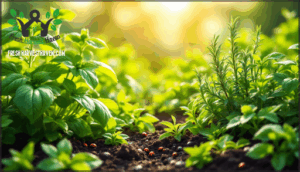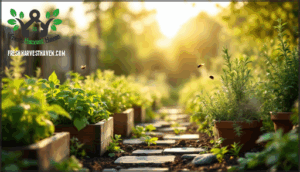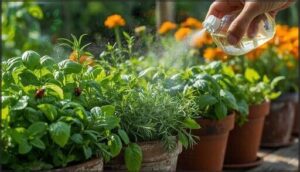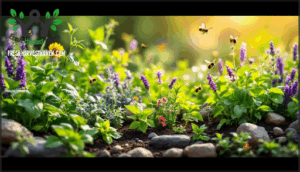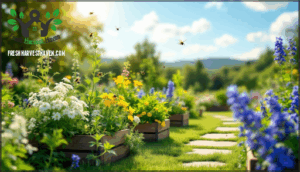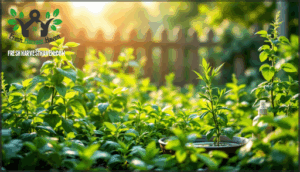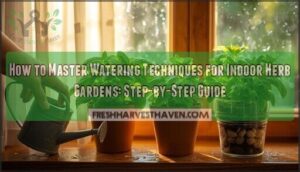This site is supported by our readers. We may earn a commission, at no cost to you, if you purchase through links.
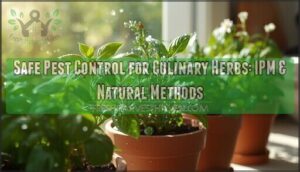
The challenge isn’t just that pests threaten your herb yields—it’s that conventional chemical controls often leave behind invisible contamination in the very plants you’re growing for your kitchen.
Fortunately, safe pest control for culinary herbs doesn’t require choosing between a thriving garden and your family’s health. By understanding how pests actually behave and adopting strategies that work with your garden’s natural systems, you can grow clean, abundant herbs while maintaining the ecosystem balance that keeps your plants genuinely protected.
Table Of Contents
- Key Takeaways
- Why Safe Pest Control Matters for Herbs
- Integrated Pest Management (IPM) for Herb Gardens
- Natural and Organic Pest Control Methods
- Attracting Beneficial Insects to Your Herb Garden
- Disease Prevention and Management for Herbs
- Frequently Asked Questions (FAQs)
- Do beneficial bugs eat herbs?
- How do I keep bugs away from my herb garden?
- Do aphids eat herbs?
- How do I get rid of ladybugs in my herb garden?
- How do you get rid of fleas & flies on herbs?
- How often should I inspect herbs for pests?
- Can I eat herbs immediately after applying treatments?
- Which pests most commonly attack culinary herbs?
- How do I remove pests from harvested herbs?
- Conclusion
Key Takeaways
- Culinary herbs face stricter pesticide regulations than ornamentals because they’re classified as food crops, yet studies show 82-89% of tested herb samples contain detectable pesticide residues—often exceeding safety limits by significant margins.
- Integrated Pest Management (IPM) reduces insecticide use by up to 95% without sacrificing yields by combining monitoring, cultural practices, biological controls, and action thresholds instead of blanket chemical applications.
- Strategic companion planting with herbs like basil, mint, thyme, and flowering plants creates a self-regulating ecosystem that repels harmful pests while attracting beneficial insects like parasitic wasps and predatory beetles.
- Disease prevention through sanitation, proper air circulation, and biological control agents like Trichoderma and Bacillus subtilis eliminates the need for chemical fungicides while protecting harvest quality.
Why Safe Pest Control Matters for Herbs
When you’re growing herbs you plan to eat or use for healing, what lands on those leaves matters more than you might think. The regulatory landscape treats culinary herbs as food crops, which means stricter rules govern what you can spray and how much residue can remain.
Let’s look at why safe pest control isn’t just good practice—it’s essential for protecting your health and getting the most from your harvest.
Food Safety and Pesticide Regulations
Culinary herbs are regulated as food crops, not ornamentals, making pesticide oversight markedly stricter. Few pesticides receive registration for herbs, and regulatory bodies require maximum residue limits before approval. Your herb garden must comply with food safety standards—especially critical for medicinal and culinary use where residues pose real health risks.
- Fewer registered pesticides available compared to ornamental plants
- Maximum safe residue amounts must be established pre-registration
- Chemical applications heavily controlled under food safety regulations
- Integrated Pest Management offers compliant, effective alternatives
Understanding these constraints isn’t limiting—it’s liberating. You’re choosing methods that protect your family while building a healthier growing system. Establishing pesticide residue standards is vital for safe herb cultivation.
Risks of Chemical Pesticide Residues
Here’s the reality: residue testing reveals a troubling pattern. Studies show that 89% of Chinese herb samples contained detectable pesticides, while 88.9% of fresh and dried herbs in Connecticut testing did the same. Cilantro tested particularly high at 94.6% residue presence. These aren’t trivial amounts—herb samples averaged 1.05 ppm per sample, over ten times higher than typical market foods. Chlorpyrifos, an organophosphate, appears most frequently across studies.
Residue testing shows 89% of herb samples contain detectable pesticides, with concentrations ten times higher than typical foods
Even more concerning, Connecticut herb samples violated residue limits in 82.2% of cases versus just 2.95% for all foods. Chemical exposure through contaminated herbs poses genuine risks to your family’s health, especially with cumulative multi-residue occurrence. That’s precisely why integrated pest management and organic methods matter—they eliminate these dangers entirely.
Understanding the health risk assessment is vital for safeguarding the safety of herbal medicines.
Importance for Culinary and Medicinal Uses
When you’re growing herbs destined for your kitchen table or medicine cabinet, the stakes shift dramatically from ornamental gardening—what you harvest becomes what you consume. Culinary and medicinal herbs demand rigorous pest management because chemical residues accumulate in plants you’ll ingest directly. Unlike ornamental crops, herbs face stricter pesticide regulations since they’re classified as food or consumable products.
Your herb quality control hinges on sustainable farming practices that eliminate contamination risks:
- Culinary herbs like basil and cilantro absorb pesticides readily, concentrating residues in leaves you cook with
- Medicinal herb uses require absolute purity—users consume larger quantities seeking therapeutic benefits
- Integrated Pest Management protects both your crop and your family’s health through biological control methods
- Sustainable agriculture practices build soil health while preventing pest pressure naturally
- Herb cultivation without chemical inputs guarantees your harvest remains safe from seed to harvest
This is why integrated pest management and organic pest control strategies aren’t optional—they’re essential safeguards for food you’ll serve to people you care about.
Integrated Pest Management (IPM) for Herb Gardens
Integrated Pest Management offers a practical framework for keeping your herbs healthy without relying on heavy chemical sprays. Rather than reaching for pesticides as a first resort, IPM combines regular monitoring, smart cultural practices, and targeted interventions to tackle problems before they spiral.
You’ll learn the core principles that make this approach work, the scouting techniques that catch issues early, and how to layer different control methods together for lasting results.
Principles of IPM for Herbs
IPM treats pest control as a system rather than isolated treatments. Your approach combines knowledge of pest biology with multiple strategies—cultural practices, monitoring, biological controls, and targeted interventions. The key principle is to act only when pest populations reach economic thresholds. Research shows IPM reduces insecticide use by up to 95% without sacrificing yield, while regular scouting catches problems early, cutting costs by 25%.
| IPM Component | Outcome |
|---|---|
| Action thresholds | 95% reduction in unnecessary sprays |
| Early detection via monitoring | 25% lower intervention costs |
| Biological controls | 60–85% pest population reduction |
This integrated approach gives you control, safety, and sustainable yields.
Monitoring and Scouting Practices
Your eyes are your first line of defense—regular monitoring catches pest problems before they spiral out of control. Establish a consistent crop inspection routine using yellow sticky cards to track adult whiteflies, aphids, and thrips.
During plant scouting, check leaf undersides and soil for larvae. Monitor stock plants and propagation areas weekly.
This early pest surveillance feeds your integrated pest management strategy, allowing targeted biological control releases when thresholds are reached rather than blanket spraying.
Combining Cultural, Mechanical, and Biological Controls
Think of pest management as a three-legged stool—remove one leg, and the whole thing topples over. Your cultural practices form the foundation: proper spacing, air circulation, and sanitation eliminate pest breeding grounds.
Mechanical barriers like row covers physically exclude insects from vulnerable seedlings.
Then add biological control agents—parasitic wasps and predatory insects—to target remaining pests naturally. Together, these integrated strategies create sustainable methods that protect your herbs without chemical residues, giving you the control and freedom you’re after.
Natural and Organic Pest Control Methods
Regarding growing herbs for your kitchen, chemical pesticides aren’t your only option—and often aren’t the best one. Organic and natural pest control methods give you effective protection while keeping your herbs safe to eat and your garden thriving.
Here are the practical approaches that’ll help you manage pests without compromising the quality of what you grow.
Benefits of Organic Pest Control
When you ditch chemical pesticides in favor of organic methods, you’re not just protecting what ends up on your dinner plate—you’re building a healthier garden from the ground up. Organic pest control reduces toxicity to you, your family, and beneficial insects while promoting soil health and sustainable methods.
These natural remedies work with your garden’s ecosystem rather than against it, creating lasting pest resistance through biological control and integrated pest management approaches.
Companion Planting Strategies
Companion planting works like a neighborhood watch for your herb garden—certain plants standing guard beside others to keep pests at bay while inviting the good bugs to stick around.
Strategic plant pairings create a natural defense system. Mints repel aphids and ants, while basil deters flies and mosquitoes. Thyme attracts parasitic wasps that eliminate harmful insects. These herb combinations work together through integrated pest management, reducing your reliance on sprays entirely.
Your garden layout matters too. Alternating herbs with complementary crops prevents pest buildup and improves soil health through crop rotation. This approach transforms your bed into a self-regulating ecosystem where beneficial insects thrive and destructive ones struggle to gain ground.
Key companion planting strategies:
- Plant basil near tomatoes to repel whiteflies and spider mites
- Combine thyme with other herbs to attract parasitic wasps and predatory beetles
- Use mint as a border plant to deter ants and common garden pests
- Rotate herb placements seasonally to break pest cycles and improve soil enhancement
- Interplant rosemary with vulnerable herbs to protect against fungal issues and aphid damage
DIY Natural Pest Repellents and Sprays
Making your own pest sprays puts the power of protection directly in your hands—no waiting for shipments or worrying about what’s really in that bottle.
Mix neem oil with water and insecticidal soap to create a potent natural pest repellent that disrupts insect lifecycles. Garlic and pepper infusions work as effective herbal remedies against aphids and spider mites. Steep fresh herbs in water, strain, and spray directly on affected plants.
These DIY pest control formulas cost pennies, break down quickly in soil, and leave no toxic residues on your culinary herbs.
Attracting Beneficial Insects to Your Herb Garden
Your herb garden can work as a living pest management system when you know which plants to use strategically. Rather than relying solely on sprays or barriers, you can invite nature’s own pest controllers into your garden by growing specific herbs alongside your culinary plants.
Below you’ll discover which herbs repel unwanted insects, which ones attract the beneficial predators and parasites that hunt them, and how to create an ecosystem that keeps everything in balance.
Herbs That Repel Harmful Pests
Your herb garden is naturally armed with botanical defenses that many common garden pests find absolutely intolerable. Mints—particularly peppermint and spearmint—are powerhouse pest repellent herbs that deter ants and aphids through their potent aromatic compounds. When you plant these in sufficient quantity, they create a protective barrier across your garden.
Consider incorporating these natural deterrents into your herb garden planning:
- Mints repel aphids, ants, and whiteflies
- Basil deters thrips and flies
- Rosemary discourages beetles and moths
- Lavender repels mosquitoes and moths
This organic pest control approach transforms your herb garden into a self-defending ecosystem, reducing reliance on external interventions and supporting integrated pest management (IPM) strategies.
Herbs That Attract Beneficial Insects
While repelling pests is half the battle, the real magic happens when you invite the good guys in—the beneficial insects that’ll do the heavy lifting for you. Flowering herbs like dill, fennel, and cilantro attract parasitic wasps and predatory beetles that feast on aphids and thrips. Borage draws pollinators while its nectar nourishes hover flies, natural pest controllers.
By strategically planting these insect-friendly herbs throughout your garden, you’re building an integrated pest management system where nature manages pest suppression naturally, reducing your reliance on any external interventions.
Creating a Balanced Ecosystem
The key to a thriving herb garden isn’t just eliminating pests—it’s building an ecosystem where everything works together to keep problems in check. When you combine repellent herbs with beneficial insect attractors, you create natural barriers that discourage harmful pests while supporting predators and parasitoids.
This ecological harmony reduces your dependence on interventions. Biodiversity conservation through diverse plantings strengthens soil health and establishes the integrated pest management foundation where your garden largely regulates itself.
You’re not just growing herbs; you’re cultivating a self-sustaining system.
Disease Prevention and Management for Herbs
Even with the best prevention practices, diseases can still find their way into your herb garden—and catching them early makes all the difference. The good news is that you don’t need harsh chemicals to manage most herb diseases; there are proven methods that keep your plants healthy while protecting your harvest.
Here’s what you need to know to identify problems, stop them in their tracks, and maintain a thriving garden.
Common Herb Diseases and Identification
Fungal infections like powdery mildew and Fusarium wilt strike basil hard—affecting up to 80% and 60% of crops, respectively, under poor conditions. Bacterial spots create water-soaked lesions with yellow halos on parsley and cilantro, while root rot from overwatering damages 35% of greenhouse herbs. Viral symptoms show stunting and mottled leaves.
Learn these signs early: powdery coating on leaf undersides, one-sided yellowing, grayish-purple spots. Catching diseases fast through regular scouting lets you deploy biological control and adjust watering before pest management becomes crisis mode.
Biological Disease Control Agents
Once you’ve identified the disease threatening your herbs, nature offers its own army of microscopic allies that can help you fight back without chemicals. Biological disease control agents—specialized fungi and bacteria—suppress pathogens while staying safe for culinary use. These microbe applications work preventively or curatively, making them ideal for integrated pest management strategies where chemical fungicides pose residue risks. Deploy them early through biocontrol methods alongside sound cultural practices.
- Fungal controls like Trichoderma species colonize roots, outcompeting harmful pathogens
- Bacterial sprays containing Bacillus subtilis prevent foliar diseases organically
- Organic fungicides derived from beneficial microbes offer residue-free disease suppression
- Biocontrol methods integrate seamlessly with pest management strategies for complete protection
- Beneficial insects and microbial agents create synergistic ecosystem health, reducing disease pressure naturally
Sanitation and Environmental Controls
Before disease takes root, think of your herb garden as a living system that thrives on prevention rather than cure—and that’s where sanitation and environmental controls become your first line of defense. Remove diseased plant material promptly to interrupt pathogen spread. Sterilize tools between plants, maintain clean water systems, and guarantee proper air circulation to reduce humidity where fungal diseases flourish.
Manage waste thoroughly, practice crop rotation, and monitor soil health regularly. These foundational practices work synergistically with biological control agents and integrated pest management strategies, creating ecological balance that naturally suppresses disease pressure while keeping your culinary herbs safe and thriving.
Frequently Asked Questions (FAQs)
Do beneficial bugs eat herbs?
No, beneficial insects don’t eat your herbs—they feed on harmful pests. These garden allies, including ladybugs and lacewings, target aphids and other destructive bugs while leaving your culinary plants untouched.
Their presence strengthens your garden ecosystem, making them essential partners in Integrated Pest Management and natural pest control strategies.
How do I keep bugs away from my herb garden?
Strong roots, smart choices, and vigilant eyes—that’s your defense. Use physical barriers like row covers, set bug traps, maintain soil health through composting, select pest-resistant herbs, and design your garden layout using Integrated Pest Management (IPM) principles with companion planting to attract beneficial insects.
Do aphids eat herbs?
Aphids do feed on herb bedding plants, sucking sap from tender new growth and leaves. You’ll notice herb damage symptoms like curled or yellowed foliage, sticky honeydew, and stunted growth.
Fortunately, organic aphid control through natural aphid repellents, biological control agents, and targeted insecticides keeps these pests manageable without compromising your harvest.
How do I get rid of ladybugs in my herb garden?
Wait—ladybugs are allies, not enemies! They devour aphids and harmful pests. If you’re seeing masses, gently relocate them outdoors.
Use garden barriers or natural deterrents sparingly, focusing Integrated Pest Management (IPM) and natural pest control methods on actual threats to your herbs.
How do you get rid of fleas & flies on herbs?
You’ll need sticky traps and natural herb sprays as fly repellents, while biological control and beneficial insects target fleas.
Integrated pest management combines pest barriers, natural pest control methods, and pest control materials for lasting protection.
How often should I inspect herbs for pests?
An ounce of prevention is worth a pound of cure—inspect your herbs daily during active growth.
Regular scouting and pest inspection are vital for integrated pest management (IPM), enabling early detection for effective biological control and natural pest control methods.
Can I eat herbs immediately after applying treatments?
Treatment wait times depend on what you applied. Biorational pesticides usually allow harvest within 24-48 hours, while some organic sprays have zero-day intervals.
Always check pesticide residue limits and herb safety guidelines on product labels. Rinse thoroughly before consumption to reduce foliar injury risks.
Which pests most commonly attack culinary herbs?
Like uninvited guests at a garden party, aphids, whiteflies, thrips, spider mites, and fungus gnats frequently target culinary herbs.
Proper pest identification facilitates effective aphid control, whitefly management, and thrip infestation prevention through targeted monitoring strategies.
How do I remove pests from harvested herbs?
You can rinse harvested herbs under cool running water, then gently shake them dry.
For persistent pests, submerge herbs in cold saltwater for several minutes before rinsing thoroughly and air-drying or using dehydration techniques.
Conclusion
Your herbs thrive when you recognize what pests and gardens share: both respond to patterns of abundance and scarcity. Aphids cluster where nitrogen accumulates. Mildew follows excessive moisture. These aren’t random invasions—they’re feedback signals from your garden’s ecosystem.
Safe pest control for culinary herbs succeeds when you address root causes rather than symptoms, building resilience through diverse plantings, vigilant monitoring, and biological allies that maintain balance without contamination. Your cleanest harvest comes from understanding that protection and health are inseparable.

